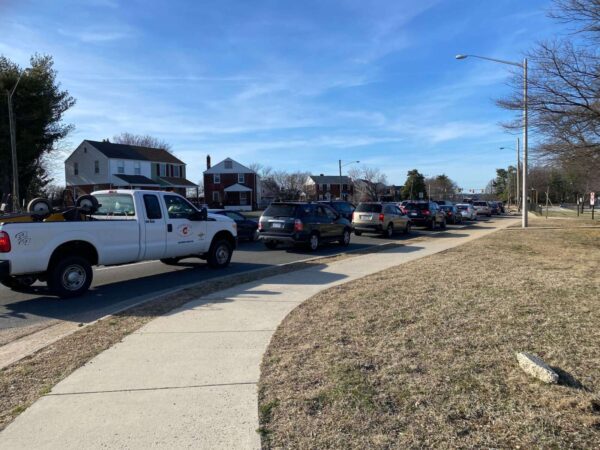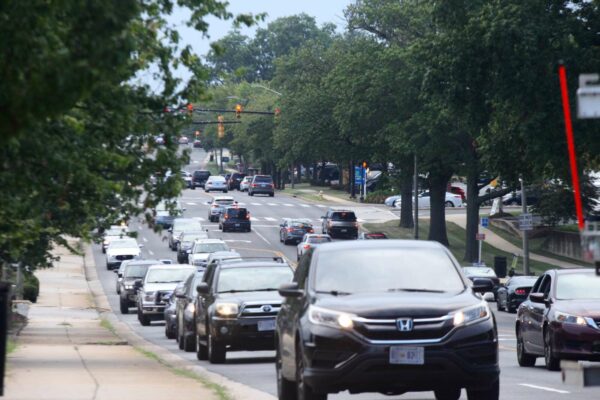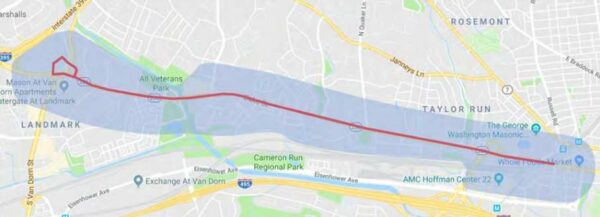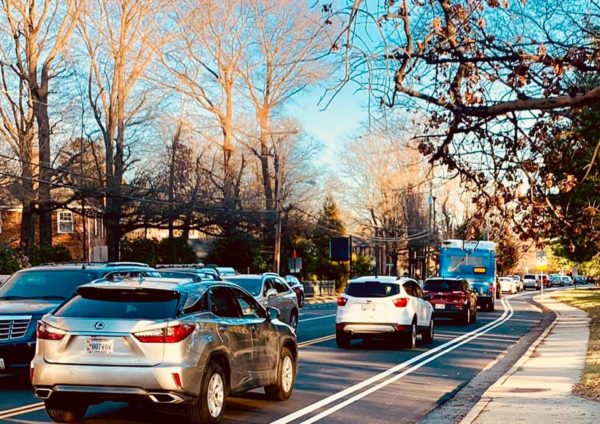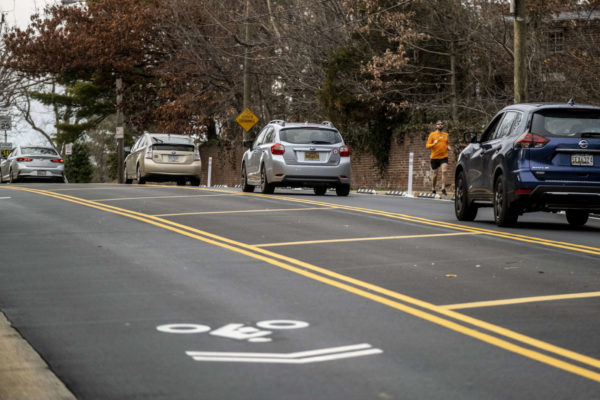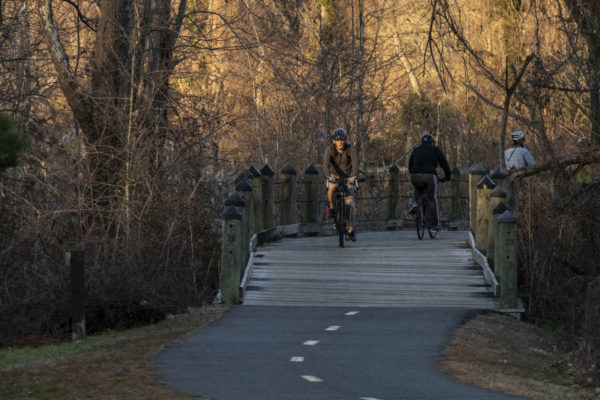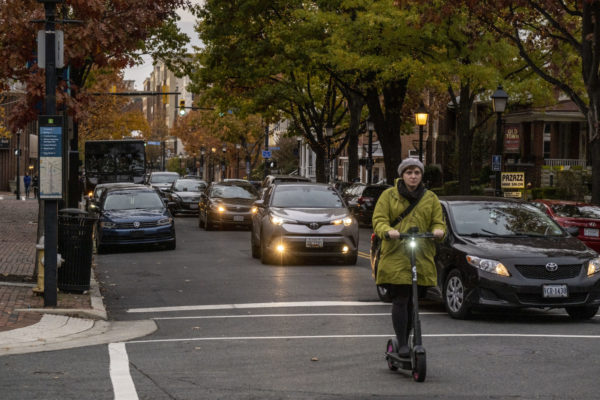The Virginia Dept. of Transportation is mulling expanding the Express Lanes system to a section of I-495 from Fairfax County across the Woodrow Wilson Bridge and into Maryland.
The city of Alexandria, however, is skeptical of the current plans, as many of the alternatives come down to adding traffic lanes. Staff say these changes could hamper attempts to get people out of their cars and onto public transportation, including future transit across the bridge.
VDOT has wrapped up a study of how to improve transportation and reduce rising congestion along this segment of I-495. So far, it has come up with several preliminary alternatives, including adding general purpose lanes, express lanes or reversible express lanes and allowing part-time shoulder use.
“We are evaluating transportation improvements that would extend and provide continuity of the express lanes system on the southern section of the Capital Beltway,” said VDOT project manager Michelle Shropshire in a September public meeting.
In his most recent newsletter, Mayor Justin Wilson said the city has expressed to VDOT its concerns regarding “induced demand, increased cut-through traffic, potential impediments to future transit connectivity over the Wilson Bridge and more.”
“The City has generally had a ‘cautiously skeptical’ stance towards similar proposals in the past,” Wilson said. “We have worked with the Commonwealth to ensure that these projects generate revenue for transit initiatives and include protections to prevent such efforts from exacerbating cut-through traffic on City streets.”
Traffic on I-495 — between Route 1 and the Woodrow Wilson Bridge — is also a concern, however.
There is severe eastbound congestion from 3-7 p.m. starting at the Van Dorn Street interchange, Shropshire said.
“Travel through this area is often impacted by accidents,” she said. “During the Covid pandemic, there was a significant decrease in traffic volumes but we are currently experiencing traffic at or above pre-pandemic volumes.”
Now that a slate of alternatives have been identified, the next step for VDOT is to gather feedback and select a handful to evaluate via an environmental assessment. People can learn about the project and answer a short survey online or write to VDOT with their comments.
A preferred alternative is expected to emerge next spring.
In his newsletter, Wilson shared what city staff said about the study in a letter sent to VDOT sent last month:
- The criteria provided, including continuity of the Express Lane system, seem to bias the selection of alternatives towards those that include new Express Lanes, rather than those that prioritize transit and transportation demand management measures.
- Additional lanes may lead to additional demand on; therefore, increased traffic on the facility overtime.
- Reduction in congestion may reduce the number of crashes, but it could cause increased severity of crashes as vehicles are able to travel at higher speeds.
- Express Lane options could add constraints on providing new transit, specifically Metrorail lines on this corridor and across the Woodrow Wilson Bridge in the future.
- New access points from I-495 to and from Alexandria could cause increased traffic on City streets.
- Right-of-way impacts have not yet been identified, and project limits should be minimized to minimize the impacts on adjacent and nearby properties.
VDOT has said that the alternatives it will consider for I-495 will be informed by a concurrent transit study.
In addition to incentives for riders, this recently completed transit study recommends new bus service, arguing it would be more cost-effective than rail, per the September presentation.
Woodrow Wilson Bridge was designed with additional space for future transportation needs and to accommodate future rail across the bridge, according to VDOT.
“Future rail service on the bridge would not be precluded by 495 Southside Study alternatives,” says the transportation agency.
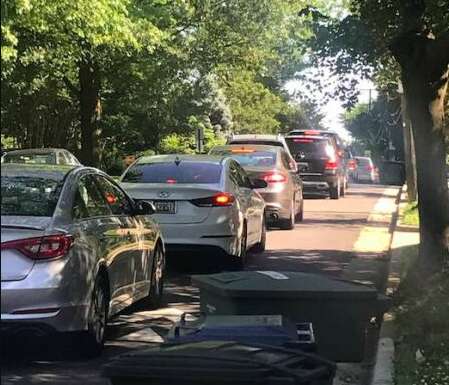
After years of struggling with terrible traffic and frequent crashes, recent changes to West Taylor Run Parkway have had a substantial impact on the trouble street’s residents.
Alexandria city staff are recommending that a Duke Street Traffic Mitigation pilot — which redirects traffic flow onto Duke Street and off of “cut-through” streets winding through nearby neighborhoods — be made permanent.
The pilot program changed traffic signal timing to prioritize green lights on Quaker Lane and Duke Street while shortening the lights on the cut-through roads, the goal being to disincentivize using the side streets to get around traffic on Duke Street.
At a meeting of the Traffic and Parking Board on Monday, West Taylor Run Parkway resident Leslie Catherwood said the change has had a dramatic impact on residents of the street.
“I’d like to start off by thanking the city for proposing this project and to thank the board for considering permanently closing Telegraph Road from West Taylor Run,” Catherwood said. “As a homeowner on West Taylor Run, this project has vastly improved our quality of life.”
Catherwood said prior to the change, it was nearly impossible for some residents to access their driveways given how backed up traffic was on the street.
“Prior to the change, I could not get into or out of my driveway at all for seven days a week at all hours of the day,” Catherwood said. “The traffic would back up on my street from Duke Street all the way to Janney’s Lane. West Taylor Run became a parking lot.”
Other residents previously told ALXnow the street was prone to frequent crashes. But while it’s not perfect — northbound traffic remains an issue on the street — Catherwood said some of that has changed with the new pilot program.
“Today, we don’t have a problem of this magnitude anymore with southbound traffic,” Catherwood said. “Since the project started, we’ve seen changes in traffic patterns. We no longer have a parking lot on West Taylor Run. The southbound traffic no longer backs up for the entire street.”
The Traffic and Parking Board voted unanimously to recommend the change be made permanent.
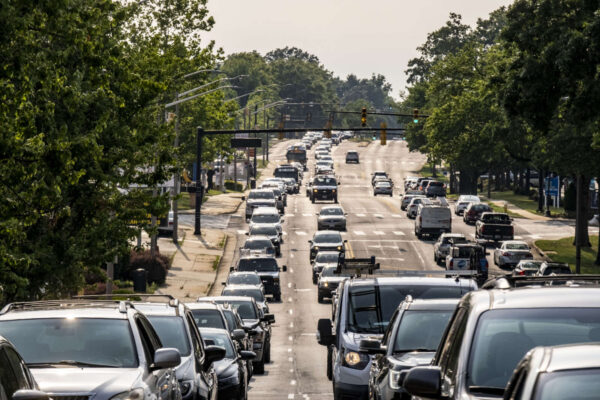
Alexandria transportation officials say that a pilot program to ease evening congestion on and around Duke Street is working and they want to make the changes permanent.
City staff announced last night (Wednesday) that the first and second phases of the Duke Street Traffic Mitigation pilot have improved evening peak traffic and reduced cut-through traffic near the busy roadway. The project launched last summer with extended green traffic lights on Quaker Lane and Duke Street from 4 to 6 p.m., while green lights were shortened on West Taylor Run Parkway, Cambridge Road, Yale Drive and Fort Williams Parkway.
“We did have very positive results on cut-through traffic for most roads,” said Dan Scalese, a senior transportation manager with the city. “This has been a benefit. We’ve seen reductions in cut-through [traffic] and that Duke Street is moving.”
Traffic volumes decreased on Cambridge Road by 48%; on West Taylor Run Parkway by 54%; on Yale Drive by 76% and on Fort Williams Parkway by 47%. Cut-through traffic did increase, however, on Quaker Lane by 39%.
“We obviously saw more Quaker Lane backup,” Scalese said. “Our next step is to essentially going to a maintenance-type mode, (where) this is now considered a permanent infrastructure feature. We will be monitoring the networks, not just one area, and tweaking as necessary.”
City staff will discuss the mitigation phases in a meeting at Bishop Ireton High School on Monday, April 17. The proposal then goes to the Traffic and Parking Board at 7 p.m. at City Hall on Monday, April 24.
In the meantime, city planners are also working on ways to improve bus transit — as well as bicycle and pedestrian facilities — along Duke Street from Landmark Mall to the King Street Metro Station.
Dubbed Duke Street in Motion, the project proposes a series of congestion-relieving changes such as dedicated bus lanes along the center of the road or the curb and bus-rapid transit stations every half-mile.
City Council is expected to approve a preferred alternative for the project in July.
There are major traffic delays leading up to Interstates 495 and 395 in Alexandria, as a trucker convoy protesting COVID-19 mandates has entered D.C. and created miles of backups.
Traffic snaked all the way down to Jefferson Manor, just south of Huntington, which is about a half-mile from the interstate.
The convoy drove through the area last week without incident.
Heads Up, Friends! There's expected to be increased commercial and passenger vehicle traffic on the Beltway (I-495) and I-395 today.
— VDOT Northern VA (@VaDOTNOVA) March 14, 2022
California, New York and Pennsylvania where just some of the trucks that are currently grinding traffic to a halt on 395 north… police and DDot blocking access to downtown. Soooo if you happened to be trying to get home like me, it’s going to be a while… pic.twitter.com/oztQNCUyWE
— Tommy McFLY (@TommyMcFLY) March 14, 2022
#BREAKING: Expect heavy traffic delays along I-395, Southbound DC-295 to I-495 due to the trucker convoy from Hagerstown. @DCPoliceDept are closing some streets and exits into DC to keep traffic moving. https://t.co/L1sdaVv9hy
— 7News DC (@7NewsDC) March 14, 2022
After more than 10 years in development, the high-capacity Duke Street Transitway is getting the show on the road.
The Alexandria City Council, at its meeting March 8, will vote on authorizing the city manager to appoint an Ad Hoc Duke Street Transitway Advisory Group. The nine-person body will spend the next year providing recommendations for corridor design alternatives, and will endorse a preferred alternative by spring 2023.
The new advisory group will be tasked with adopting or amending the 2012 Transit Corridors Feasibility Plan, which outlines the project below:
- It would create dedicated transit lanes in existing six-lane sections of Duke Street between Landmark Mall and Jordan Street and between Roth Street and Diagonal Road
- In the remaining section of Duke Street between Jordan Street and Roth Street, transit would operate in mixed flow
- A parallel off-corridor bicycle facility should be examined to accommodate bicyclists along Duke Street and improved pedestrian facilities would be provided at intersections and near transit stations
- Preliminary implementation should prioritize enhanced pedestrian safety and improvements at Taylor Run Parkway
The advisory group will be made up of nine members:
- Transportation commissioner
- Planning Commissioner
- Alexandria Commission on Persons with Disabilities member or designee
- DASH Bus Riders Group member or designee
- Three at-large community representatives
- Representative of the development community
- Federation of Civic Associations member or designee
The city manager will designate a chair of the advisory group, and choose the three at-large members.
Seminary Road has experienced some delays since the city implemented the contentious “road diet” last fall, Alexandria officials acknowledged at a Tuesday night city council meeting.
After months of pressure from an extremely vocal group of city residents on Facebook, council members peppered staff with questions about the road diet — a reduction of a 0.9 mile stretch of Seminary Road between N. Quaker Lane and Howard Street from four to two lanes, plus the addition of bike lanes on both sides, a center turn lane, crosswalks and medians.
The city’s most recent traffic data shows a travel time increase of one minute for vehicles going westbound on Seminary from Quaker Lane to Jordan Street at peak travel times (8:15 a.m. and 5:15 p.m.) and a 30 second increase in the opposite direction. The data was collected with the city’s Bluetooth travel time monitoring system. On the plus side, staff said, the road is now otherwise safer for pedestrians, cyclists and drivers.
Alexandria City Councilwoman Amy Jackson called for a reversal of the road diet in December and spent more than an hour questioning city staff on Tuesday night. During her questioning, she had an aide present a slideshow of photos of traffic along Seminary Road.
“Hundreds of people took hundreds of pictures, because that’s what they’re doing because they’re sitting there,” she said. “I’m not convinced that our city government has alleviated the fears (of the public).”
City transportation planners said that the roadway might be minimally slower for drivers during peak hours, but that it is safer for pedestrians and cyclists.
“For the vast majority of the day the road is performing the same, if not better than before,” said Hillary Orr, deputy director of the city’s department of Transportation and Environmental Services. “And for those other 23 hours, it’s designed in a way that is comfortable for people who are walking, biking, using transit and driving their cars. And that’s one of the tradeoffs that we have talked about throughout this process.”
Fire Chief Corey Smedley told council that his staff was in communication with city staff as the road diet was being planned, and that fire and emergency vehicles have been un-hindered in their ability to navigate through traffic and answer service calls — assertions that run counter to the beliefs of road diet opponents, who have cited a FOIAed trove of emails as proof that fire department brass were pressured into supporting the changes.
When Jackson asked him if his department was in consultation and agreement with the plan, he responded by saying, “Absolutely.”
Police Chief Michael Brown reported that there have been three reported car crashes along the roadway since the road diet was implemented last fall, including one that occurred at the conclusion of a high speed chase by the Virginia State Police. Otherwise, he said, the road diet has presented no issues for police.
Council voted 4-3 for the road diet last October, supported by Mayor Justin Wilson, Vice Mayor Elizabeth Bennett-Parker, and council members Canek Aguirre and Del Pepper. In opposition were Jackson, and council members John T. Chapman and Mo Seifeldein.
Bill Rossello wasn’t convinced by the staff presentation. The Seminary Hill resident sat in on the meeting for more than two hours before calling it a night and walking out.
“It’s absolute horse hockey,” Rossello told ALXnow. “The city is not very good at presenting data, gathering data and what it’s really not good at is listening to the overwhelming majority of community members who actually use the road, who see it first-hand, live it every day. Not a bit.”
Wilson said he expects community activism regarding the road diet to continue.
“There are going to be differences of opinion, there are going to be things that we don’t always 100% see eye-to-eye on,” Wilson said. “I appreciate the collaboration on this and so many other matters. I want to thank the community for all of their comments on this. I’m sure they will continue, and that’s a great thing and we can continue this discussion as we move forward and evaluate this project as we committed to do from the beginning.”
But Rossello, who is an administrator of the Alexandria Residents Against the Seminary Road Diet Facebook group, said Tuesday night’s meeting didn’t sit well with him.
“What we’re seeing at the leadership levels is that there seems to be a willingness to go along with this narrative that we were all involved talking about this throughout the process, which is absolutely not true,” he said. “They know that there are more cars on the road, and narrowing roads isn’t gonna make it better. That doesn’t make our quality of life better. I don’t think anything that happened tonight increases the trust that the community has in our city government.”
Photo via Alexandria Residents Against The Seminary Road Diet/Facebook
Nicole Radshaw is all in favor of the much-maligned Seminary Road diet.
Three years ago on Halloween, the Seminary Valley resident was hit by a driver as she biked to work at a preschool on Seminary Road. Radshaw didn’t break any bones, but her bike was totaled, she spent a year in physical therapy, and saw a counselor to help deal with the trauma and anxiety of being hit by a car.
“It really sucked. I could have been a fatality. Cars were driving past as I was lying on the road,” Radshaw told ALXnow. “It took me three years to want to get back on a bike again.”
Radshaw belongs to a less vocal portion of city residents who favor the road diet, which has created consternation throughout Alexandria. Mayor Justin Wilson and city officials have acknowledged traffic delays at peak travel times since the 0.9 mile stretch of roadway between N. Quaker Lane and Howard Street was reduced from four to two lanes. Bike lanes on both sides were also added, in addition to a center turn lane, crosswalks and medians.
The city council and Department of Transportation and Environmental Services have received thousands of emails and messages against the plan. Arguments from the Alexandria Residents Against the Seminary Road Diet Facebook group even prompted Alexandria City Councilwoman Amy Jackson to call for a complete restart of the process.
Glenn Klaus lives in Rosemont, and his support of the road diet is more philosophical. He’s a cyclist and hasn’t yet biked on the new Seminary Road bike lanes, but wants to see fewer cars on city roadways.
“The city is trying to change driving behaviors and traffic patterns. People just have to deal, because ultimately I think that strategy is to their benefit,” Klaus said. “When people lose, it doesn’t mean they weren’t listened to. It just means their argument didn’t sway the decision-makers.”
Lisa Soronen lives on Fort Williams Parkway — about five blocks away from Seminary Road — and alternates between taking the bus in the morning and driving to work in the District. She walks her dog in the morning and crosses Seminary Road on foot up to six times a day, which used to be a “suicide mission,” she said. Now she says that drivers are paying more attention to the 25 mile per hour speed limit and she is no longer afraid of crossing the street.
“It’s absolutely wonderful, because if I want to cross the road I have a crosswalk,” Soronen said. “Same thing with the bus. Coming home after 5 p.m., I’d have to run across four lanes of traffic and someone might hit me. I’m really surprised that people feel so personal about it, and they have attacked me personally. I have been attacked online.”
Soronen said she has experienced delays along the roadway in the morning, and has seen emergency vehicles speed through the middle turn lane without issues . She got involved in the planning process for the roadway soon after moving into the neighborhood last April, and has corresponded with members of the city council and city staff.
“I might be delayed sometimes driving on Seminary, but it’s worth it for me for it to be safer for everyone,” she said. “The process I participated in seems open and fair. If things had gone the other way, I don’t think I would have considered that the process failed me.”
Soronen is an attorney and volunteers with the Mother of Light Center, which supports homeless Alexandrians. She said that the argument over the road diet is a waste of her time and distracts city council from its other work.
“I don’t understand the vitriol against this,” she said, calling the dispute “small and petty” and not as big of a deal as, say, poverty and homelessness in the city.
Lead in Soil Near Oronoco Bay Park — “Research for the Combined Sewer Overflow remediation project uncovered a mysterious cache of lead along the waterfront… It was during exploration at CSO-001, the outfall near Oronoco Bay Park, that RiverRenew came across the lead… RiverRenew is taking extra precautions to remove the impacted soil.” [Alexandria Times]
T.C. Teacher Goes Extra Mile — T.C. Williams 11th grade English teacher Corrina Reamer, who teaches immigrant and international students with limited English proficiency, has raised money for a library of 1,000 books “so her students would learn to love reading.” [Washington Post]
Mag Lists Alexandria Traffic Concerns — “In the past month, we asked Alexandria residents to answer this question: ‘What is your biggest concern about transportation and/or commuting in the Alexandria area, and what do you think should be done to make it better?’ Here are the responses we received.” [Alexandria Living]
Local Robotics Team Advances to State Tourney — “The St. Stephen’s and St. Agnes School Upper School robotics team Thunderstone advances to states! They competed January 11-12 at the Salem Qualifier and finished the day as the top-ranked team and captained the winning alliance.” [Zebra]
Three months after a portion of Seminary Road was re-paved and re-striped to reduce it from two vehicular lanes in each direction to one lane, a turn lane and bike lanes, the debate over the “road diet” still rages on.
On the now-private Alexandria Residents Against the Seminary Road Diet Facebook group, numerous posts per day bemoan the state of rush hour traffic along Seminary Road, report on cut-through traffic on nearby roads, and rip Mayor Justin Wilson for his support of the project. (Wilson, a member of the group, often politely replies to the invective.)
No one is denying that the road diet is causing some level of increased traffic during certain times. Earlier this month Wilson wrote in his Council Connection newsletter that there were still increased delays for drivers on Seminary Road, but they were largely confined to narrow peak rush hour periods and were improving over time:
During the evening rush, the peak travel period has been 5:15 PM to 5:30 PM. Prior to the change, the average travel time from the intersection of Quaker Lane and Seminary Road to Jordan Street and Seminary Road was 3.5 minutes. In November, after the changes were implemented, we saw a 40% increase in this travel time, with an average of 4.9 minutes. In December (excluding holidays and days when school is not in session), the average travel time was down to 3.9 minutes, an increase of 24 seconds from before the changes.
During the morning rush, the peak travel period has been 8:15 AM to 8:30 AM. Prior to the change, the average travel time from the intersection of Quaker Lane and Seminary Road to Jordan Street and Seminary Road was 3.6 minutes. In November, after the changes were implemented, we saw a 98% increase in this travel time, with an average of 7.1 minutes. In December (excluding holidays and days when school is not in session), the average travel time was down to 4.7 minutes, an increase of a bit over a minute from before the changes.
This morning, a review of traffic conditions via Google Maps showed mostly clear sailing as of 8:45 a.m. The city’s traffic monitoring service similarly showed a 25 mph average speed on Seminary and Janneys Lane, between N. Beauregard Street and King Street, from 8-9 a.m. this morning.
Google Maps reports higher levels of “typical traffic” and delays around 8 a.m. on most weekdays.
Ultimately, the Seminary Road question is one of priorities. Should the city’s priority be to reduce rush hour delays for drivers? (And, potentially, emergency vehicles — though no issues have been reported so far.)
Or should the city stick to its guns and sacrifice some commute times in the name of pedestrian safety and encouraging other forms of transportation, like bikes and scooters?
Let us know what you think in the poll and the comments.
Map via Google Maps
Fox 5: No Additional Delays on Seminary — Alexandria’s Seminary Road controversy has taken another turn in the local TV news spotlight. This time, Fox 5 looked at the lane reduction issue and concluded that the brief periods of gridlock on the road during peak times are not, in fact, worse than it was when the Seminary was two lanes in both directions. [Fox 5, Twitter]
Population, Housing Continue to Grow — “Alexandria’s housing inventory is barely keeping up with its population growth. That’s a key takeaway from Alexandria’s recently released fiscal 2019 Comprehensive Annual Financial Report… The city added an estimated 2,300 residents in the last year, climbing to 156,800, and roughly 2,900 total residential units, ending fiscal 2019 with 82,310.” [Washington Business Journal]
New ACPS Trying Out Healthy Recipes — “Alexandria City Public Schools recently welcomed a new executive chef to its cafeterias and he’s already got some fresh ideas. Chef Isaiah Ruffin wants more vegetarian options on the menu, less sodium in the lunch items, and about 80 percent of the ingredients to be locally sourced.” [WDVM]
Local Cop Dedicated to Helping the Homeless — “In Alexandria, Officer Bennie Evans goes far beyond the call of duty to work with the homeless — often using his time and money to help — with the goal of building a stronger community altogether. ABC7 joined him on an autumn day at Alexandria’s Meade Memorial Episcopal Church as Evan cooked up lunch for more than a hundred people.” [ABC 7]
Reminder: Weekend Events — A number of significant events are taking place in Alexandria this weekend, including the Alexandria Cider Festival, the holiday tree lighting in Old Town, and the inaugural Alexandria Makers Market at Port City Brewing.


